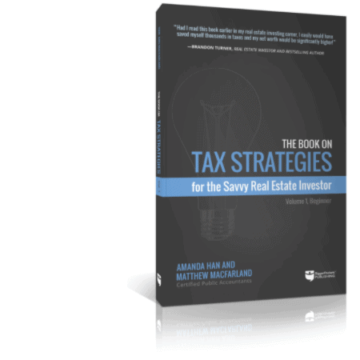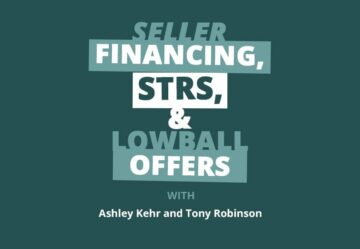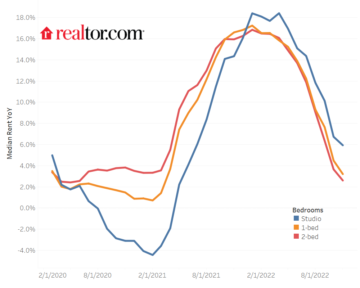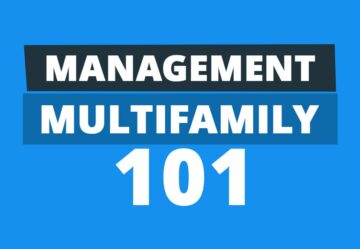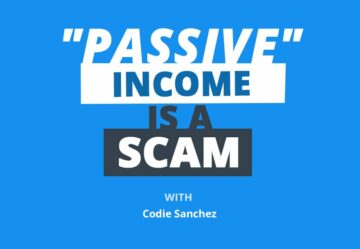
One real estate market is ready to explode, haunted houses and “dark tourism” become all the rage, tiny homes are the new affordable housing, and multifamily investors find colossal cash flow with homeless housing. It’s halfway through 2023, and no real estate investing opportunity can be taken for granted. Long gone are the times of buying any house and counting on cash flow to come through every month. If you want to know the REAL ways to make money in real estate, this is the episode for you!
We’re back with the full On the Market podcast panel, as Henry, James, Jamil, and Kathy bring in news stories affecting real estate investors nationwide. First, Henry talks about a “micro-home” community of tiny houses helping home buyers lock in a mortgage for almost half the average cost. Then, James touches on California’s consistent struggle with homelessness and how multifamily investors can profit by building safe spaces for those that need a helping hand.
Kathy brings the inside scoop on a new resort development that could shoot one city’s home prices through the roof. Finally, Jamil makes us all feel slightly uncomfortable by mentioning “dark tourism” and how buying haunted houses could give you a huge ROI as tourists beg to be terrified. If you want to know about all the unconventional yet high-profit housing market opportunities, stick around!
Click here to listen on Apple Podcasts.
Listen to the Podcast Here
Read the Transcript Here
Dave:
What’s up everyone? Welcome to On the Market. This is Dave, your host, joined with everyone today, Jamil, James, Kathy, Henry. Everyone, how are you?
Jamil:
Good. I answer for everyone, I guess.
Henry:
We’re good.
Kathy:
So happy to be together.
Dave:
All right. Jamil, are you and Henry recording from the same place?
Jamil:
He’s actually just in the other room. No, we’re both in Phoenix, Arizona. He’s at Hot Bobby’s studio, which as you can see by the sign is mediocre at best. Mine on the other hand is not.
Dave:
Bobby, how would you describe Bobby, Jamil?
Jamil:
Hot.
Dave:
What is his job though?
Jamil:
His job is videographer and motivational speaker.
Dave:
Okay, all right, got it.
Jamil:
He pep talks me, he’s like, “It’s okay. It’s okay. Yes, you are built like a bag of milk, but people like you.”
Dave:
That’s great, I need a Bobby in my life. That would be nice.
James:
Did you say built like a bag of milk?
Jamil:
Somebody actually said that to me on a live stream last week, and I was stumped.
Dave:
What?
Jamil:
Somebody said, “Hey, Jamil, congratulations on the weight loss. You’re looking great.” And then somebody else was like, “What are you talking about? He’s built like a bag of milk.” And I’m like, “Wow, I haven’t heard that one before. Geez.
James:
All right, that’s a first.
Dave:
I think you’re looking great, man.
Jamil:
I actually went… I tracked down a bag of milk very soon after that and I was poking it, and I’m like, man, what?
Henry:
At least 2%.
Dave:
Such a mean thing to say.
James:
I’m saving that one.
Dave:
I think you’re looking great.
Jamil:
Thanks.
Dave:
They’re straight up wrong.
Kathy:
Well, everybody loves milk, so let’s get [inaudible 00:01:42].
Dave:
I don’t know. I’m lactose intolerant.
Kathy:
Me too. Me too. Sorry.
Dave:
Yeah, so we both [inaudible 00:01:51]
Henry:
Nobody actually likes milk.
James:
Now that we’ve lost our farming sponsors.
Dave:
Cheese. I can get on board with cheese. All right. Well, Bobby nailed the Henry Washington purple, for anyone who’s not watching it.
Henry:
He did that just for me.
Dave:
[inaudible 00:02:04] he’s got your perfect hue going on.
Kathy:
Yeah.
Dave:
All right. Well, for today’s show, we’re going to do our correspondence show, which if you listen to this podcast regularly, you know it’s our format where each of the cast members brings an article that they found interesting and pertinent to the real estate investing community. But today we’re focusing it a little bit on opportunities in unique markets. So each panelist is going to bring a story about a unique place in the country that has some sort of potential for real estate investors.
Before we get into that, Kailyn has teed up a pretty hard game for us. I don’t know how you guys are going to do on this. It is a history game. So I’m going to ask you all questions about the history of the housing market, and I want to see how well you guys understand this. The first question I’m going to direct at James, because he looks the most nervous. The question is, when was the first mortgage issued in the United States?
James:
I have not the slightest clue.
Dave:
All right. Give me a century. What century do you think it is?
James:
I’m going 1900s.
Dave:
Okay, that’s a good guess.
James:
And I’m going to go with 1918, final answer.
Dave:
Okay. All right. 1918, world War One. Okay. Kathy.
Kathy:
1776. Because I just feel like people-
Dave:
Whoa.
Kathy:
Yeah. I’m just going there.
Jamil:
Alexander Hamilton.
Dave:
They just came out the gate, Declaration of Independence, mortgages, next thing.
Kathy:
And then banker was like, “Dude, I can so take advantage of this situation. Yes.”
Henry:
That actually sounds right.
Dave:
Okay. Henry, what do you got?
Henry:
1802.
Dave:
Ooh, okay.
Henry:
For absolutely no reason.
Kathy:
That’s a good number.
Dave:
Jamil.
Jamil:
Well, I’ve looked at a lot of houses and I’ve seen a ton of construction in the late 1800s and early 1900s, and my opinion would be that you’d see more construction as affordability or more mortgages became available to people because they need to borrow money. So I’m going to say 1890.
Dave:
1890 is similar to what I was going to guess. I just think maybe it was like a post civil war reconstruction effort to stimulate the economy. I’m going to go 1872. And let’s see what we’ve got. Kailyn, on the big board. Whoa. Okay. Kathy, pretty close. 1781 was the first ever mortgage issued.
Jamil:
Wow.
Dave:
God, there’re bankers always.
Kathy:
What took them so long?
Jamil:
So you’re telling me that the republic is interwoven with credit?
Dave:
Yeah. It’s remarkable to think about Jamil.
Jamil:
Wow. Can’t believe it.
Dave:
All right. Second question, in what year did the US federal government start selling off land? Henry.
Henry:
1802.
Dave:
18… I like it. He’s just going to keep… Kathy, you started this on the very first episode, we started guessing. You just said seven and a half for everything.
Kathy:
I was wrong.
Dave:
Henry’s just going to say 1802 for everything. All right, Jamil.
Jamil:
Well, I think we probably needed to start selling stuff pretty soon after the formation. So my guess is going to be 1790. I like 90 for some reason.
Dave:
James.
James:
I’m with Jamil. I’m going 1777. They started trading dirt right out the gate. Think of how much potential there was to sell dirt back then. It was just an open canvas.
Jamil:
Oh, that was a wholesaler’s dream. Except there’d be no comps. There’d be no comps. I could just make up… Hey, that’s just like today, people just making up ARV. Right? That’s like, “Hey, you buy this. Who knows? It might… White House over here, it could be worth a lot one day.”
Kathy:
If someone buys it, you’ve just established value. So yeah.
Dave:
Kathy, what’s your guess?
Kathy:
Well, since you said I like sevens, then we’ll go with 1777. Why not?
Dave:
All right. I’m not going to guess because I just saw the answer. But Henry, his strategy’s working, it was 1802. No, it was 1800.
Jamil:
Wow. Oh, wow.
Dave:
It was 1800, but extremely close. All right, last question. When was the lowest annual mortgage rate ever recorded in the United States? Jamil.
Jamil:
2020.
Dave:
Henry. Don’t say 1802.
Henry:
1801.
Dave:
Okay. Pushing your luck. All right, Kathy.
Kathy:
Can I tie with Jamil? 2020.
Dave:
All right. James.
James:
April of 2019.
Dave:
Okay. Pre-pandemic, huh? It was in 2021.
Kathy:
Oh.
Dave:
Well, we’re going to take a quick break and then we’ll be back after the break.
Henry:
After these messages.
Dave:
We’re going to take a quick break and we’ll be right back with our correspondence show.
Welcome back, everyone for our correspondent show. Today we’re going to be talking about unique opportunities and situations in given markets across the US that we think that you as investors should know about.
Henry:
So look, I brought a story that I thought was super cool. So affordable housing is a problem all across the country. You also have the problem of impoverished communities feeling like they don’t have access to homeownership. And I am privileged to have met this developer who did this project, and I thought, what a cool opportunity to be able to share this because I feel like this is a play that can be run in many larger cities and an opportunity that other developers across the country could take advantage of.
So there is a Black developer by the name of Booker T. Washington who built a 29-home, micro-home community. So these are larger than tiny homes. They’re going to be between 330 feet and 630 square feet. So larger than tiny homes. So 29 micro homes in College Park in the Atlanta area. And so this is a predominantly Black neighborhood where a lot of working class individuals live, and there’s not a lot of access to affordable housing, nonetheless, homeownership. And what they were able to do by building these micro homes was to build… And they’re really nice, modern-looking homes that they’ve built.
And what they did was they were able to build these homes and then build them at an affordable price. So the purchase price for these homes were between 200,000 and 230,000. And if you look at the average home price in Atlanta, it’s around 400,000. So you’re getting a house for essentially half the price, albeit it’s a little smaller, but it’s still a home. So you’re getting a house for about half the price, which puts your mortgage somewhere between 13 and 1700. So call it $1,500 for a mortgage, which is less than rent in a lot of places in Atlanta.
And so people now had opportunity to own homes in their community. They didn’t have to leave their community to find something nice. They didn’t have to leave their community to spend their money somewhere else. They could keep the money in the community, they could keep their jobs in their community. And what I thought was really cool about this was the land that they built this community on was vacant, abandoned land. It wasn’t producing any tax revenue for the city. And so they were able to take land that wasn’t producing anything for the city, and now, that land is producing tax income, the houses are providing affordable homes. It’s a nice community. People don’t have to leave their community. And it was also a profitable venture for the developer.
And so I feel like that’s a win all the way around. I think we talk a lot about affordable housing as a problem. And really that problem just means what? Problems mean opportunities. When I was in the corporate world, they didn’t let us say the word problem. They made us say the word opportunity instead of the word problem, because every problem is just an opportunity to solve something. And so I think this was a creative way to create affordable housing and keep people in a community rather than feeling like people have to be forced out.
Dave:
That’s awesome. Wow. Very cool story. So is it the public private partnership that allowed that property to be built at such a low cost?
Henry:
I’m not sure. Now, he’s a seasoned developer. He’s been building other communities before. And so I’m sure he’s got… I’m sure the build cost wasn’t anything different than what he’s normally building, but the size of the house is also smaller than a typically normal house. So you’re not spending as much on the build either.
Dave:
Was this the first time this guy did a development like it?
Henry:
I believe it’s the first and only Black-developed, micro-home community in the country.
Dave:
Wow. Cool. Well, hopefully with all the success it will be a sort of blueprint for future opportunities.
Henry:
That is what I hope as well.
Dave:
All right, great. Well, thank you for sharing that story. Super cool. All right, James, what story do you have?
James:
Mine, it’s similar to Henry’s. I pulled an article that talks about the amount of money that’s being spent to develop homeless shelters in Sacramento. Sacramento has allocated over 50 to 60 million dollars to develop anywhere between 2 and 300 affordable housing… not really affordable housing, more for shelter, for living, where they’re going to provide food services. And this is all based around fixing the homeless situation. And the reason I found it so interesting is A, there’s opportunities that come with that. We currently own a 68 unit rooming house in Capitol Hill in Washington. And because of the demand, and the city has been spending so much money on homelessness or also on just subsidizing people that need help, what it’s done for us on that specific building is it actually turned our building into a 40% cashflow building. Because we were approached by the state and they offered us a ridiculously high rent to secure the building, and they locked it up for a long period of time.
So as an investor, sometimes we look at this and we’re like, okay, that’s not really good for the market. You’re bringing in homeless shelters that in theory, the New York Times reported that on average that drops your property values by 15 to 20%. So it’s definitely something you want to be aware of that’s being planned in your neighborhood because it could reduce your value. But as a buy and hold investor, if you’re buying multifamily in that area, at the end of the day, they don’t have enough units. They’re spending 50 to 60 million dollars and it’s only going to help about 5% of the total homeless. That’s going to get about 2 to 300 people into housing. There’s 4 to 5,000 that need housing in Sacramento alone. So it’s barely moving the needle.
And one thing I did want to point out, because I think Henry’s article is really good because it shows working with the private sector in how they made something that works financially for everybody. But if you really break down the cost of what’s being allocated right now, they’re developing 2 to 300 tiny houses. Those on average cost, 40 to $60,000 to create. They are spending 200 to 300,000 to put every one of those units in. And it’s completely inefficient. And if they could become efficient they could help three times more people, if not more, at that point.
But it’s always something, as investors, you want to be paying attention to what’s going on in your city, what’s going on in your jurisdiction. Because as stuff like this is happening in our major cities, it’s happening in Seattle, it’s happening in L.A., Sacramento, across the nation, it’s a need that must happen. We have people living on the streets, they need to get in housing, they need to get help, but they need to do it in the right way. But as investors, you have to pay attention to this because if you’re looking at buying a single family rental property in that area, the value could go down.
Now, if you’re buying multifamily in there, you start reaching out to states and you can actually get some state contracts that will actually help you substantially. And it will save the state money at that point. By them renting our huge rooming house, they’re paying a fraction of what they’re spending in Sacramento on these housing… to house these people.
And so the private sector, it actually makes more sense financially, like what Henry was just talking about, that the government works with the private sector because they actually can reduce the cost. And it’s good for the private sector because you actually get paid a little of a higher return too. So it’s win-win if they can put it all together. But it’s definitely something as this homeless crisis across the United States is happening, you need to pay attention to what’s being developed, where’s the money being allocated, and what pivots do you need to make as you’re putting together your portfolio.
Dave:
Yeah, it’s super interesting. I hadn’t really heard some of the stats about property values and how they’re impacted by this type of stuff. You hear a lot about sort of NIMBYism, where it’s like people don’t want it in their backyard. So it’s a really challenging problem to try and correct because we do need housing and to be able to provide options and services to these people. But obviously it seems like most people don’t want the services provided anywhere near where they live. So it creates a really difficult situation for these governments.
James:
We got toasted on a house one time. It was in 2013-ish, around there. We bought this property, great craftsman home, great area of Seattle. And then after we closed, we were waiting on permits, a sign goes up that there’s a tiny house development going in across for homeless. And it was a year-long contract. Basically, they were doing these pop-up, tiny homes around the city of Seattle for a while-
Dave:
They used to do that in Denver.
James:
The house became unsellable. When we were done, not one person would buy that house. And this is back when pricing was a lot more affordable too. And we ended up having to keep that as a rental for two years because it just would not trade. So you do want to pay attention as you’re buying your investments. I don’t think it’s bad to have rental property in the area, but if you’re doing short-term development flips, you want to be a little bit careful. You don’t want that extra objection in your deal.
Kathy:
Yeah, I mean, we’ve tried all kinds of things in California. And Malibu became, I don’t know if you guys know this, but became a sanctuary city. And over Covid, all of the beachfront parking became homeless homes and they would park RVs and their cars and LA passed a law saying that you could live in your car. And of course, the people of Malibu actually wanted that. They want to find a solution for the homeless. What we discovered is that crime increased dramatically and there weren’t really the services for people. There were no bathrooms. So it’s just bad. Bottom line is a homeless problem is different than an affordability problem. To me, the homeless problem is more of an opioid or mental health issue and just providing some housing isn’t going to fix it. But I’ve talked about this before.
James:
No, or at least figure out how to provide housing that works for the masses. These plans are half plans. They’re not even half plans, they’re 10th of a plan because they’re spending all the budget and then making minimal impact. And it’s like, you spend the budget, help the people, but make the impact. And it really comes down to government waste, government spending, they don’t know how to develop stuff. They don’t know how to build things.
I heard they were building 80 Us for 800 grand in L.A. How do I get the contract for that? I will build those all day long. For us, it costs us 340 grand to build that. The inefficiency and wasted dollars means no one’s getting help. It’s a nice theory, but they need to put the right plan behind it, just like everybody has to do for building out a business. If you want to build out a business or build out something that’s going to be successful, you’ve got to think it all the way through, where I feel like it’s just this splash drop in. And at the same time, it’s going to affect people. If you own housing in that space, your property could be worth less. You might want to sell and relo out. It’s definitely something that has to be addressed, but they need to refine how they’re doing it because it’s not working.
Dave:
All right. Kathy, what is your opportunity that you’ve been looking at?
Kathy:
We’re going to go in a very, very different direction from the first two. I tend to love getting into areas before something big happens, but you kind of know it’s coming. It can be a little bit risky because that big thing may actually never happen. But if it does, that’s where you can really make a lot of money. If you buy an old property in an area where, again, something huge is coming in.
So you all know that I love the Park City area. I love Utah. I think they’re creating massive jobs there. And a lot of the tech industry, they’re calling it Silicon Slopes. What a lot of people don’t know, and now the word is out, as of this moment, that right behind Deer Valley, they are building a brand new ski resort. It’s called the Mayflower. Mayflower Mountain Resort. And for years, they didn’t think this thing was going to happen. So if you bought in the area and it didn’t happen, then… I don’t know. Do you guys know where Heber Valley is? It’s not a well-known area unless you’re a fan of Park City.
So the houses out there have been fairly cheap. But when this ski resort gets built and it’s going to be… Just look at this, the Mayflower Mountain Resort will be North America’s newest world-class Alpine Village to be developed since 1981. So to me, this is a huge deal in an area that’s already growing. You know that Utah’s growing, you know that Salt Lake is growing, and there’s this new resort. So if you wanted to invest in the resort, you’re going to have to have some deep pockets. I imagine the homes are going to be in the millions for this if you want to be ski and ski out.
However, if you still want to buy one of the older homes nearby, I think there’s a huge opportunity close by. There is a development where there’s going to be a Tiger Woods golf course, and then where I’m investing is a brand new development that’s not mine, but could be. We may partner with these guys. But a friend of mine, actually who I met through Ken McElroy, bought my dream. He bought a hot springs.
Dave:
Whoa.
Jamil:
Wow.
Kathy:
Yeah, he bought… Like how do you buy a hot springs? But he did it. And he’s going to have all these houses so you can go ski at the Mayflower, this brand new resort with all new equipment, all new cool stuff, and then go home and just jump in the hot springs. So I love the idea. I think it’s really cool. I think you could go in anywhere in the area and make money if you wanted to buy in this hot Springs development. The way he’s selling it is the way I’ve been talking about selling in our Park City development, which is the fractional shared vacation ownership.
Because one of the biggest wastes of property, and I see it all the time where I live, is rich people come in and buy vacation property and never use it. So you’ve got world-class property that sits empty and it’s awful. It’s disgusting. But if you’re able to share it with several owners, so it’s always being used, but how often are you going to use it if it’s a vacation home? And in this case it’s six to eight weeks, which is more than most people vacation. And I think the buy-in for one of those four bedroom homes, it’s in the two or 3 million dollar range, is 300,000 for your share. So it’s not for everybody, it’s not out of range for everybody, but it’s also not in range for everybody. But it’s cool. But again, you could buy an old house in the area and do very well.
Dave:
James, what do you think?
James:
I like this.
Dave:
You’d probably be… Yep, exactly. He’s the only one who could afford it. So I think…
James:
I had the privilege of staying at Kathy’s, one of Kathy’s units or one of the units that they developed in Park City, and it’s an amazing place. There’s so much growth there. And then what kind of blew me away was the amount of bodies that were on that mountain and in that city.
Dave:
James is scarred by this experience.
James:
Oh, I turned around and left all the way out there. I got there, I looked at the line, I’m like, no, I don’t do lines.
Henry:
Me either, buddy.
James:
But this is really needed. And then it was like this, you could hear the chaos in the ski lines. People are like, “Do we go to Deer Valley?” They’re like this quest to find a good mountain. So I mean, the demand’s definitely there. And I mean, around that city, you could see how much in Park City was developed in the last 10, 20 years. And the fact that it’s so close to that downtown city too, it was a really cool experience. But I think it’s really needed. It’s in high demand and it is definitely going to do what Kathy said, and that’s bring property values up because that’s where the money’s going. Money is going to raise the values, and amenities are going to raise the values, along with this hot springs Tiger…
It seems like Tiger Woods is doing golf courses throughout the nation. He’s just selling his name. I read on three articles with him on the golf course, but it’s going to bring money in and values will go up.
Kathy:
Oh, I forgot to add, there’s also Deepak Chopra in the development that I’ll be investing in, possibly partnering and syndicating in. He, Deepak Chopra’s going to create a wellness center there. And wellness centers are really on the rise. People want to live longer. There’s a huge generation of baby boomers who want to be healthy. And so there’s just a lot of big names tied to the area. And again, that’s always good for arising real estate values.
Dave:
All right, cool. That’s a good one. I like it. Jamil, what did you bring?
Jamil:
Okay, so before I get a bunch of hate mail from people about this, I just want to say that I chose something really outside the box, and it’s about dark tourism. And the article that I brought, and where I found it was… It actually listed for sale, JonBenét Ramsey’s home, where she was found dead. And again, it’s never a tourist attraction when something happens to a child. However, what I do want to say is dark tourism is alive and very, very, very, very lucrative for people who are willing to invest in properties where gruesome crimes have happened. For whatever reason, we have an obsession as a nation to want to see these places.
And so if you look up the Texas Chainsaw Massacre house, I mean, it’s a massive draw. If you’re ever in Los Angeles and you want to see the, what’s that TV show that Ryan Murphy does, American Horror Story House, the American Horror Story House, there’s always people outside. There’s always people wanting to get in. It’s a huge draw. And so I’m thinking it’s pretty well known that if something really gruesome happens in a house, that it’s hard to sell right away. So hear me out. So let’s just say for instance, you’re tracking these gruesome crimes and you decide, okay, what I’m going to do is I’m going to offer 30 cents on the dollar for these things, and I’m just going to hold on for a little while. Once the emotions settle, I can put it on Airbnb or something like Accord and possibly cash in.
So today, I think there’s a unique opportunity in dark tourism. I want to button this by saying right now at that house is worth 8 million dollars, or almost 8 million dollars. They’re selling it for just under 8 million bucks. And when the crimes happened and when it was sold, it sold in the 400 thousands. So we’re talking a massive appreciation from purchase and it’s way beyond the appreciation of the neighborhood. It’s way beyond the appreciation of other homes in the area. And I believe the reason for it is because of the story attached.
Dave:
That’s interesting. I mean, Boulder is a very expensive market. I’ve driven by this house. It’s in a very nice area, in a very expensive market. But are you saying people should buy it and then turn it into a museum, or you just think someone else is going to buy it even for more because of the history to it?
Jamil:
I think that you could monetize it by turning it into a museum. Which again, look, the ethics around that are questionable. But I mean, I just think there’s a fascination. I think there’s an opportunity. Look, I’ve driven down Bundy Drive before in hopes of being able to find the OJ House and learned that they’ve demolished it. So I mean, why would I even want to drive by? I’m not a weirdo or a sicko. But I was like, “I’m on Bundy Drive. I think something really crazy happened there.” And I Googled it. I’m like, “Oh my God, OJ Simpson, let’s find the house.”
Dave:
All right. Well, thank you all for bringing these stories. We greatly appreciate it. And thank you all for listening. I’ll see you for the next episode of On The Market.
On The Market is created by me, Dave Meyer, and Kailyn Bennett. Produced by Kailyn Bennett, editing by Joel Esparza and Onyx Media, researched by Puja Gendal. Copywriting by Nate Weintraub. And a very special thanks to the entire BiggerPockets team. The content on the show On the Market are opinions only. All listeners should independently verify data points, opinions, and investment strategies.
Watch the Podcast Here
In This Episode We Cover
- The rise of haunted house investments and the surprising profits of “dark tourism”
- Tiny houses, “micro-homes,” and other affordable housing options home buyers are looking for
- How to get paid by providing housing to the homeless IF you own this type of rental
- The new resort development that could cause home prices to explode in this ski town
- Why the government WANTS investors to turn vacant land into low-income housing
- And So Much More!
Links from the Show
Interested in learning more about today’s sponsors or becoming a BiggerPockets partner yourself? Email [email protected].
Note By BiggerPockets: These are opinions written by the author and do not necessarily represent the opinions of BiggerPockets.
- SEO Powered Content & PR Distribution. Get Amplified Today.
- PlatoData.Network Vertical Generative Ai. Empower Yourself. Access Here.
- PlatoAiStream. Web3 Intelligence. Knowledge Amplified. Access Here.
- PlatoESG. Automotive / EVs, Carbon, CleanTech, Energy, Environment, Solar, Waste Management. Access Here.
- BlockOffsets. Modernizing Environmental Offset Ownership. Access Here.
- Source: https://www.biggerpockets.com/blog/on-the-market-122
- :has
- :is
- :not
- :where
- $UP
- 000
- 1
- 10
- 10th
- 13
- 15%
- 2%
- 20
- 20 years
- 200
- 2019
- 2020
- 2021
- 2023
- 24
- 30
- 300
- 40
- 50
- 500
- 51
- 60
- 8
- 80
- 90
- a
- Able
- About
- absolutely
- access
- accord
- across
- actually
- add
- ADvantage
- affect
- affecting
- afford
- affordable
- affordable housing
- After
- again
- Airbnb
- All
- allocated
- allowed
- alone
- along
- already
- also
- always
- am
- amazing
- amenities
- American
- amount
- an
- and
- Angeles
- annual
- answer
- any
- anyone
- anything
- anywhere
- Apple
- appreciate
- appreciation
- ARE
- AREA
- areas
- arizona
- around
- article
- articles
- AS
- At
- Atlanta
- attached
- attention
- attraction
- author
- available
- average
- aware
- away
- Baby
- back
- Bad
- bag
- banker
- bankers
- based
- Basically
- BE
- became
- because
- become
- becoming
- been
- before
- behind
- being
- believe
- BEST
- between
- Beyond
- Big
- Biggest
- Bit
- Black
- board
- Bobby
- bodies
- border
- borrow
- both
- Bottom
- bought
- Box
- brand
- Brand New
- Break
- bring
- Bringing
- Brings
- brought
- budget
- build
- Building
- built
- Bunch
- business
- but
- button
- buy
- buyers
- Buying
- Buys
- by
- california
- call
- called
- calling
- came
- CAN
- Can Get
- canvas
- car
- careful
- cars
- case
- Cash
- cash flow
- Cause
- Center
- Centers
- Century
- challenging
- Chaos
- cheap
- child
- Chopra
- chose
- Cities
- City
- class
- Close
- closed
- College
- come
- comes
- coming
- Communities
- community
- completely
- consistent
- construction
- content
- contract
- contracts
- Cool
- copywriting
- Corporate
- correct
- Cost
- Costs
- could
- counting
- country
- course
- courses
- Covid
- crazy
- create
- created
- creates
- Creating
- Creative
- credit
- Crime
- Crimes
- crisis
- Currently
- Dark
- data
- data points
- Dave
- day
- dead
- deal
- decide
- declaration
- declaration of independence
- deep
- deepak
- Deepak Chopra
- Deer
- definitely
- Demand
- Denver
- describe
- develop
- developed
- Developer
- developers
- developing
- Development
- DID
- different
- difficult
- direct
- direction
- dirt
- discovered
- Display
- do
- does
- doing
- Dollar
- dollars
- done
- Dont
- down
- Downtown
- dramatically
- draw
- dream
- drive
- driven
- Drop
- Drops
- each
- Early
- economy
- efficient
- effort
- eight
- either
- else
- emotions
- end
- enough
- Entire
- episode
- equipment
- essentially
- established
- estate
- Ether (ETH)
- ethics
- Even
- EVER
- Every
- everybody
- everyone
- everything
- exactly
- Except
- expensive
- experience
- extra
- extremely
- fact
- fairly
- family
- fan
- farming
- Federal
- Federal government
- feel
- Feet
- Figure
- final
- Finally
- financially
- Find
- First
- first time
- Fix
- Flips
- flow
- focusing
- food
- For
- forced
- format
- formation
- found
- four
- fraction
- fractional
- friend
- from
- full
- future
- game
- generation
- get
- getting
- Give
- given
- Go
- God
- Goes
- going
- golf
- gone
- good
- Government
- government spending
- Governments
- granted
- great
- greatly
- Growing
- Growth
- Guy
- had
- Half
- halfway
- Hamilton
- hand
- happen
- happened
- Happening
- happens
- happy
- Hard
- Have
- having
- he
- Health
- healthy
- hear
- heard
- help
- helping
- henry
- here
- Hidden
- High
- higher
- him
- his
- history
- hold
- Home
- homelessness
- Homes
- hope
- Hopefully
- hopes
- horror
- host
- HOT
- House
- houses
- housing
- housing market
- How
- How To
- However
- HTTPS
- huge
- i
- I’LL
- idea
- if
- imagine
- Impact
- impacted
- in
- Income
- increased
- independence
- independently
- individuals
- industry
- inefficiency
- inefficient
- inside
- instance
- instead
- interesting
- into
- Invest
- investing
- investment
- Investments
- investor
- Investors
- issue
- Issued
- IT
- james
- Job
- Jobs
- joined
- jpg
- jump
- jurisdiction
- just
- Keep
- Kind
- Know
- known
- la
- lake
- Land
- larger
- Last
- Late
- Law
- learned
- learning
- least
- Leave
- left
- less
- let
- LG
- Life
- like
- likes
- Line
- lines
- Listed
- Listening
- little
- live
- living
- locked
- Long
- longer
- Look
- looked
- looking
- LOOKS
- los
- Los Angeles
- loss
- lost
- Lot
- love
- loves
- Low
- lowest
- luck
- lucrative
- made
- major
- make
- make money
- MAKES
- Making
- man
- many
- Market
- market opportunities
- Markets
- masses
- massive
- May..
- maybe
- Mayflower
- me
- mean
- means
- Media
- Members
- mental
- Mental health
- messages
- met
- Meyer
- micro
- might
- Milk
- million
- Million dollar
- million dollars
- millions
- minimal
- moment
- monetize
- money
- Month
- more
- Mortgage
- Mortgages
- most
- Mountain
- moving
- much
- murphy
- Museum
- must
- my
- name
- names
- nation
- Nationwide
- Near
- necessarily
- Need
- needed
- never
- New
- New York
- New York Times
- Newest
- news
- next
- nice
- no
- normal
- normally
- North
- not spending
- now
- number
- of
- off
- offer
- offered
- often
- oh
- Okay
- Old
- older
- on
- once
- ONE
- only
- Onyx
- open
- Opinion
- Opinions
- opportunities
- Opportunity
- Options
- or
- Other
- our
- out
- outside
- over
- own
- owners
- ownership
- paid
- panel
- Park
- parking
- partner
- partnering
- Partnership
- passed
- Pay
- paying
- People
- perfect
- period
- person
- phoenix
- Pivots
- Place
- Places
- plan
- planned
- plans
- plato
- Plato Data Intelligence
- PlatoData
- Play
- player
- pockets
- podcast
- Podcasts
- Point
- points
- pop-up
- portfolio
- possibly
- Post
- potential
- predominantly
- pretty
- price
- Prices
- pricing
- private
- private sector
- privilege
- privileged
- probably
- Problem
- problems
- Produced
- producing
- profitable
- profits
- project
- properties
- property
- protected
- provide
- provided
- providing
- public
- puja
- purchase
- Pushing
- put
- Puts
- Putting
- quest
- question
- Questions
- Quick
- Rage
- raise
- range
- Rate
- rather
- reaching
- Read
- ready
- real
- real estate
- real estate market
- really
- reason
- recorded
- recording
- reduce
- refine
- regularly
- relative
- remarkable
- Rent
- Rental
- Reported
- represent
- Republic
- Resort
- return
- revenue
- Rich
- right
- Rise
- Risky
- roof
- Room
- round
- Run
- Ryan
- s
- Sacramento
- safe
- Said
- sale
- salt
- same
- Save
- saving
- saw
- say
- saying
- scoop
- seasoned
- Seattle
- Second
- sector
- secure
- see
- seems
- seen
- sell
- Selling
- sense
- Services
- settle
- seven
- several
- Share
- shared
- sharing
- she
- Shelter
- shelters
- Shoot
- short-term
- should
- show
- Shows
- sign
- Silicon
- similar
- since
- single
- sits
- situation
- situations
- SIX
- Size
- smaller
- So
- sold
- solution
- SOLVE
- some
- Someone
- something
- somewhere
- Soon
- Space
- spaces
- Speaker
- special
- specific
- spend
- Spending
- spent
- Sponsors
- square
- start
- started
- State
- States
- stats
- Stick
- Still
- Stories
- Story
- straight
- strategies
- stream
- Struggle
- studio
- substantially
- success
- successful
- such
- Super
- sure
- surprising
- Take
- taken
- Talk
- talking
- Talks
- tax
- team
- tech
- tech industry
- texas
- than
- thank
- thanks
- that
- The
- The Area
- The New York Times
- The State
- their
- Them
- then
- theory
- There.
- These
- they
- thing
- things
- Think
- Thinking
- this
- those
- though?
- thought
- thousands
- three
- Through
- throughout
- TIE
- Tied
- Tiger
- time
- times
- to
- today
- today’s
- together
- Ton
- too
- took
- Total
- Tourism
- Tracking
- trade
- Trading
- Transcript
- tried
- try
- TURN
- Turned
- Turning
- tv
- tv show
- two
- type
- typically
- unconventional
- under
- understand
- unique
- unit
- United
- United States
- units
- us
- US Federal
- use
- used
- utah
- vacation
- Valley
- value
- Values
- venture
- verify
- very
- Video
- Village
- Waiting
- want
- wanted
- wanting
- wants
- war
- was
- washington
- Waste
- watching
- Way..
- ways
- we
- week
- Weeks
- weight
- welcome
- WELL
- well-known
- Wellness
- were
- What
- What is
- whatever
- when
- which
- while
- white
- White House
- WHO
- why
- will
- willing
- win
- Win-Win
- with
- Woods
- Word
- working
- works
- world
- world-class
- worth
- would
- WoW
- written
- Wrong
- year
- years
- yes
- yet
- york
- you
- Your
- yourself
- youtube
- zephyrnet

